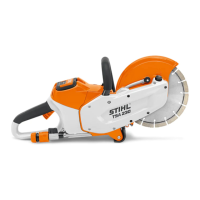TSA 230
English
20
h) Do not restart the cutting operation
in the workpiece. Let the wheel
reach full speed and carefully re-
enter the cut. The wheel may bind,
walk up or kickback if the power tool
is restarted in the workpiece.
i) Support panels or any oversized
workpiece to minimize the risk of
wheel pinching and kickback. Large
workpieces tend to sag under their
own weight. Supports must be
placed under the workpiece near
the line of cut and near the edge of
the workpiece on both sides of the
wheel.
j) Use extra caution when making a
"pocket cut" into existing walls or
other blind areas. The protruding
wheel may cut gas or water pipes,
electrical wiring or objects that can
cause kickback.
Water connection
– A water attachment kit is mounted
on the machine for use with all types
of water supply.
– A pressurized 2.6 gallons (10 liter)
water tank is available from STIHL
for wet cutting.
Use clean water for binding dust.
Most diamond cutting wheels are
suitable for wet cutting
Wet cut whenever feasible. It increases
the service life and cutting speed of
diamond cutting wheels.
Ensure that the cutting wheel is
generously supplied with water.
Wet cutting helps to suppress dust. The
water binds the dust. The cutting wheel
must be supplied with at least 20 fl. oz
(0.6 liters) water per minute.
Wet cutting can also reduce the energy
of reactive forces. In a pinch situation,
the water can act as a lubricant.
Composite resin wheels can be used for
dry cutting of metals or for wet or dry
cutting of concrete, stone or masonry.
Composite resin wheels designed for
dry cutting
Special procedures must be followed
when wet cutting with a composite non-
diamond wheel designed for dry cutting.
See the section entitled "Wet Cutting
with Abrasive Wheels" in the safety
precautions of this manual. Wet cutting
is generally not suitable for cutting
metals.
Composite resin wheels designed for
wet cutting
If the water flow rate is too high, the
cutting wheel may skim on the water
surface in the cut and greatly reduce
cutting performance. To avoid this, do
not exceed a water flow rate of about
135 fl. oz (4 L/min).
Use water properly:
1. Make certain water does not flow on
wheel that is not running, since a
composite wheel will absorb water
and that will affect wheel balance.
2. After finishing work, run the cutting
wheel at normal operating speed for
about 3 to 6 seconds without water
so that the remaining water is flung
off.
Respiratory protection
WARNING
If wet cutting at the recommended flow
rate is not utilized, the operator and any
bystanders should always wear a
respirator approved by NIOSH/MSHA
for the material being cut. Even if wet
cutting, an operator who is actively
Sample applications
Adjust water flow rate
during cutting so it is suf-
ficient to bind all the dust
that occurs (at least
20 fl. oz (0.6 L/min)).

